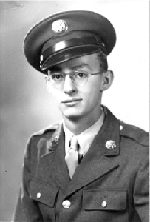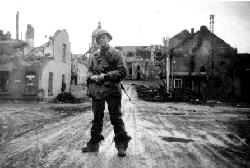The following are some excerpts from the story of U.S. Army Private First Class James Church's chapter in The Hero Next DoorTM
Portage High School graduate Jim Church knew he wanted to be an engineer since high school. Not even the Germans' Nazi army would block Church's destiny to serve his country in its greatest war so he could become the engineer that would one day help that country gain one of its greatest achievements, landing on the moon.
After one semester at the university in 1942, Church had enlisted in the U.S. Army. By late June of 1943, the private first class was following the Normandy invasion troops inland and learning to fight among French hedgerows on his way to driving the Germany Army back in the vicious Battle of the Bulge.
"Some people have trouble believing this, but in my combat pack I carried my Math 51 textbook from the University of Wisconsin-Madison, throughout the war. When appropriate, I studied this book and made notations in its margins as to where I was at that time, if I knew."
American troops had advanced several miles inland from the Normandy beaches and by the time the would-be engineer and other 1st Army soldiers arrived in mid-June of 1943.
"As support troops our task was mostly to hunker down and survive except for occasionally probing German lines with patrols to extend that hedgerow line. As many guys experienced, my first 'pants-wetting' combat event was a German artillery barrage in Normandy. The concussion of exploding shells shocks your brain and body into numbness and you are sure that you are going to die. No hole or slit trench you are in is ever deep enough and you just hunker down, hope and pray a lot.
"There were a million of us surrounded and pinned down by the German Army in 80 square miles of Normandy real estate. The town of St. Lo was the command center of the German resistance, which prevented our advance deeper into France."
Then, in mid-July, a massive American Army offensive launched, preceded by a tremendous bombardment by Army artillery and the Army Air Force. This became known as the St. Lo Breakout and started pushing the Germans into a running retreat across France. Church spent almost a year in the field, moving and fighting from Normandy through central and northern France, Belgium and Holland.
Church and his unit were trucked around a lot. And, time spent in transit and waiting for orders was mostly filled with boredom. To pass the time, soldiers tried everything from singing to cards and other "games."
"At those times when we were out of danger, well fed, rested and in good spirits, we sometimes sang while being trucked about. ... Or, we competed in target practice at trees with pick-mattocks. They were part of the Pioneer Set, which most trucks and Jeeps had on their sides. This was a frame with a shovel and a pick-mattock (a two-foot long wooden handle with a steel head, a sharp pick on one end of the head and a flat adz on the other). We would compete in accurately throwing that thing and sticking the pick in a tree, from distances up to about 30 feet. We became so deadly accurate with those things that they might have been our weapons of choice if we ever engaged Germans in hand-to-hand combat."
More than any possible weapon, buddies that looked out for you were everything to soldiers like Church. "Most of them were guys you bonded with because you were dependent upon each other to stay alive and that develops a special kind of relationship. ... Patriotism tends to fade in combat zones in favor of self-imposed peer pressure, i.e.: you and your buddies are bonded and you never let your buddies down. That's your primary motivation."
BATTLING IN THE BULGE
It's a motivation put to the test when the Nazis overran Allied lines just before Christmas of 1944. The ensuing battle to hold and regain ground through bitter cold and snow became known as the Battle of the Bulgea battle Church came to know all too well.
Church had been in a 1st Army hospital near Liege, Belgium, being treated for
trench foot (a condition where wet, frozen feet eventually turned black) for several weeks when the Germans attacked and broke through the lines in the Ardennes Forest of Belgium, just 15 miles away on Dec. 15. As the Germans' advance threatened to overrun the hospital, Church joined the fighting wounded and cooks and barbers helping to turn back the German breakthrough.
Anyone who could operate a weaponand could find oneformed the ad hoc squads and companies thrown at the Germans in the Bulge. Church himself picked up a MP-38 off a dead German soldier. "I fought with that machine pistol a long time, until I ran out of ammunition and found a more familiar American M-1. I loved the M-1 rifle because I was good with it and it kept bad guys from getting too near. At those times when I got clean shots at the bad guys and they disappeared, I usually did not know if I hit or missed and I didn't care too much as long as they didn't reappear."
But, fighting to keep warm and keep going in subzero temperatures was at times as hard a battle as any firefight.
"We were just scared kids sleeping in the cold and snow and fighting to survive any way we could. It was so cold and miserable that you sometimes didn't think dying would be so bad. I once read 'it's not hard to be cold for a day but to know you will be cold for the next day, the next week, the next month, can be very hard' and I found that to be true. We had nothing to look forward to. But it made good soldiers out of us."
Generally Church prefers not to recall specific situations of the battles he fought, especially in The Bulge, "because it takes me several days to shake them off," but he recalls one Bulge nightmare all too well.
"Lordy! It was cold. We were frozen. I believe that, the nicer the weather, the more traumatic the thought of being killed in combat. During that time in the Bulge I was so frozen that getting killed was not too unpleasant a thought.
"One night, when we were dug in on a rise (tough digging in the frozen ground) with several other squads, we had a few mortar rounds thrown at us and some rifle fire so the bad guys knew we were there.
"To make matters worse, there was bright moonlight on the snow which didn't help us hide our movements. During that night, after a couple of mortar rounds came in we began to hear some guy moaning and calling for help from somewhere out in the darkness.
"We had all heard about units of English-speaking Germans who were infiltrating our lines dressed in American uniforms and we were all pretty nervous about that. So, was this really the voice of a wounded GI or a German trick?
"The voice seemed to be coming from at least 50 yards away from the nearest one of us. Whoever it was, he was crying that he was bleeding badly. To get to him would probably have cost someone his life, so nobody tried.
"So, we listened to his voice long into the night. Then it quit.
"The next day, when we moved down off the rise we'd been on, we found his body. He was obviously an American GI."
Thanks to his faith, his buddies and some luck, Church found his way through the Battle of the Bulge and as much beyond those hard memories as he is able. He fought his way into Hamm, Germany, where he was when the Germans surrendered in May 1945. Shortly after, Church packed up to be shipped to the Pacific, after a 30-day furlough in the United States.
Church was happy to be going home, though he was uncertain about what awaited. "Home was everything to us. 'Where are you from?' was always the first question GIs asked each other. So, when I received a letter while I was overseas from my sister that told me my parents were divorced, I no longer had a home and I almost came apart.
Home is where Church got to stay since the War in the Pacific ended before he could be shipped to fight there. He married Donna Kirkpatrick 68 days after their blind date and was discharged from the Army in Jan. 25, 1946.
WINNING THE MOON
Church finally realized the dream that he carried with him in that Math 51 textbook through combat. He finished his electrical engineering degree under the GI Bill in June, 1949. Little did he know that 20 years and one month later, that engineering degree would help him propel Neil Armstrong, Buzz Aldrin and Michael Carpenter to the moon.
By the time the National Aeronautics and Space Administration in the early 1960s, Church was working in satellite programs and was recruited by NASA. He began work at the Manned Spacecraft Center in Houston Sept. 10, 1962, working exclusively on the Apollo program until shortly before Apollo 11's historic moon landing in 1969.
In the early years, Church was a project officer for Guidance and Control systems of the Apollo spacecraft and later managed the overall planning of the program.
During his years at NASA, Church worked with many early astronauts including John Glenn, Neil Armstrong and fellow Wisconsinite Jim Lovell. He worked sometime 80 hours a weekjetting hundreds of thousands of miles a year and earning a "2 million mile" plaque from United Airlines after just five years.
Shortly before Neil Armstrong made his "one small step for man and one giant leap for mankind," Church left NASA to work for Honeywell in Minnesota, helping the Japanese develop their space satellite program. He later took his skills from the skies above the earth to the soil below itbecoming an underground pioneer in ergonomics for the mining industry, with the U.S. Bureau of Mines' Research Center near Minneapolis.
During those years, Church and his wife Donna raised two daughters and two sons. They retired in 1985 and settled in Elk River, Minn. For all his many contributions to his community and country, Church remains proudest of his family and their accomplishments.
"I'm proud of my wife Donna and our kidseach of them is uniquely different, each bright, interesting and intelligent and manage their lives with a good value system and national patriotism. I am also proud of serving my country as part of its two most massive goals and victories, one military, one civilian. One, the defeat of the military machine of the Nazi despot Adolph Hitler, and the other, breaching a space frontier that earthlings had only dreamed about since the dawn of time."
This is but a small part of Jim Church's story. Read more about his contributions to winning World War II and landing men on the moon in his chapter in The Hero Next Door.




